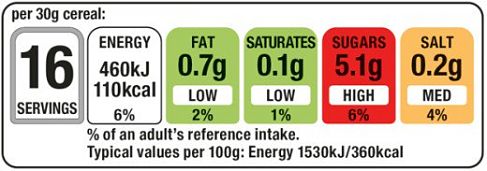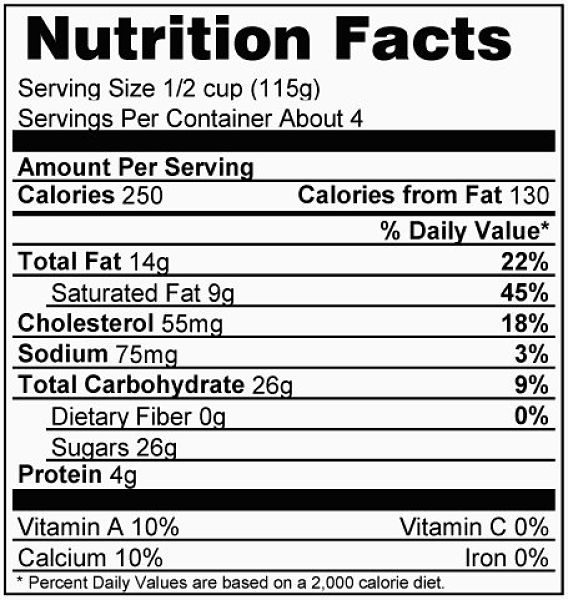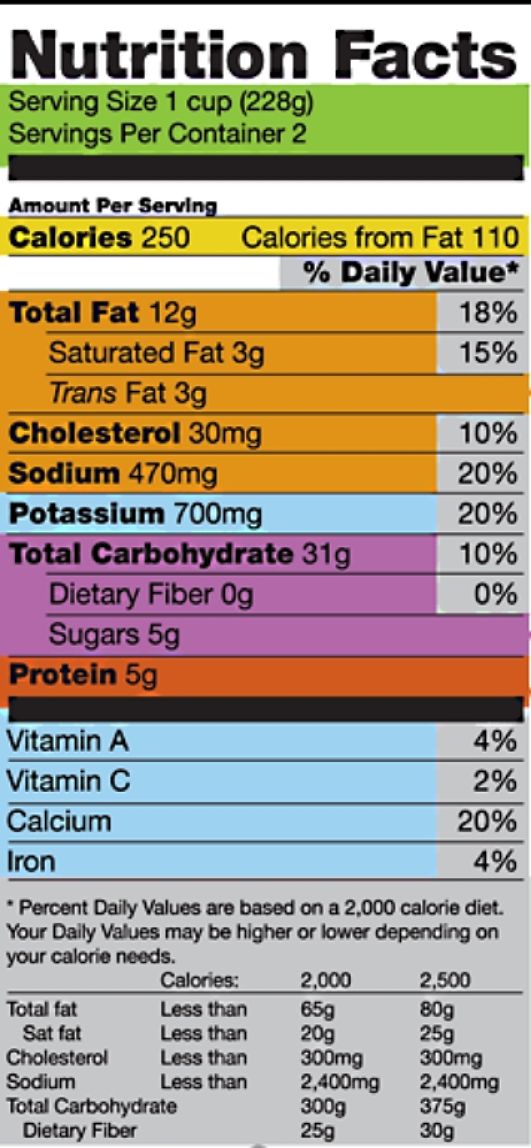Food Nutrition Labels - Fact or Fiction
Two new healthy food label systems were recently introduced: one in Australia and one in Britain, both voluntary, but heading in the right direction.
There is a critical need for labels that help people make healthy choices about the food they eat to counter the critical obesity epidemic that is engulfing the world.
There is strong evidence that the root cause of the obesity epidemic is processed food.
It is too rich and is stuffed with fat and calories. The rise in the obesity rate worldwide, coincided with the start of the major food processing revolution in the 1970s.
The normal food most people eat everyday, eating three normal meals a day, is simply processed to be too rich and too dense with calories.
People overindulge on calories passively, that is without knowing how rich the food is.
Many people get fat, not be eating junk food or fast foods, but eating 'normal' everyday foods.
You only have to look at breakfast cereals compared with plain oatmeal eaten as porridge, to be convinced of this. Processed foods are too rich.
Obesity is a huge problem, not only to the people who are over-weight, but also for Governments who face its massive cost burden on the health system. The answer to this problem is effective food labeling - real labels that have instantly recognizable messages - not just a list of calories, amounts, or percentages of daily allowance.
The labels have to inform not deceive.
So far Governments have 'pussy-footed' around with effective strategies nipped in the bud by the powerful food processor's lobby.
The new labels mark a breakthrough equivalent to health warnings on cigarette packets. The Anti-Smoking campaigns have been very effective. It's time for the Anti-Processed foods campaign to be just as effective.
The US and EU have both rejected traffic-lights labeling systems and languish in the doldrums with the percentage of daily allowances and meaningless lists of nutrient concentrations.




Australia's Five Star Food Health Rating System
The British, Australian and the old system, still used in the EU, US and most countries, are shown in the images above.
The new Australian system has just been approved by Health Ministers as a voluntary code. Attempts to have a traffic lights system in Australia failed because of intense lobbying by the food industry, as happened in the EU and US as well.
The new Australian system rates foods from half-a-star to five stars, based on overall nutritional value (see the image).
Most people are familiar with star energy rating systems for appliances, and so this concept of the good (5 stars), the bad (2-3 stars), and the ugly (1 star) should be well understood.
The major advantage of this system is that it provides an overall food rating, rather than scores for the individual components. The amounts of calories, fat, sugar and protein are displayed, but it is the overall number of stars that is important for rating the entire food.
Processed foods may be given a poor score for calories and fat, but the food may get high ratings for other nutrients, because vitamins and minerals are added to the food. This can deceive people into thinking they are good foods, but popping a victim pill after eating a bucket of fat, salt and carbohydrates is hardly going to make the food good for you in an overall sense.
The Food Industry will hate the stars system because it tells the truth: A packet of potato chips, high in salt, calories and fat with very little natural goodness is likely to get a 1 or 2 star rating (a bad food to be eaten sparingly as a treat).
The industry will fight this system because it identifies foods that are bad for you, which is the truth. Some foods are a health hazard. With a 1 or 2 star rating, fewer people will buy these 'bad' foods and sales will plummet.
The determination required to make a difference is just like the labels used for the Anti-Smoking campaigns - 'Smoking is bad for your health'. Some foods are potentially bad for your health as well, except when they are only eaten in moderation as a 'treat' in an otherwise, healthy diet. These star labels allow people to quickly access the healthiness of foods.
Additional information on the label (see the image) provides advice on the key nutrients for a healthy diet: sugars, sodium, saturated fat, and kilojoules (calories).
Certain foods such as soft drinks (sodas) and confectionery will be exempt, apart from displaying the kilojoule (calorie) content. They are artificial foods anyway and contain too few nutrients to count in any case. They probably deserve zero stars!
New British Traffic Lights Food Labels
The new UK system of front-of-pack food labelling, uses a combination of 'Traffic Lights' color coding and nutritional information (see the image).
There are effectively four traffic lights on the label with one for: fat, salt, sugar and calories.
The amounts per serving are also rated using a 'text description label' (low, medium and high) The percentage of daily allowance for the nutrient, this represents, is also shown. This label system is very comprehensive and uses a drill-down concept. The color provides a quick and easy overall rating. Consumer can check the additional details about fat or calorie contents if they want to. They can also learn what the color codings mean for various components.
Unfortunately, only 60% of foods will be covered by the new labeling system because it remains voluntary.
Companies such as Sainsbury's, Tesco, Waitrose, Asda, Morrisons and the Co-operative have agreed to display the labels on their home brand foods.
Companies such as Mars, PepsiCo, Nestle and Premier Foods have also given a favorable response.
The only draw-back from the system is that is does not provide an overall health rating for the food, like that provided by the Australian Star system. Consumers have to weigh up the four traffic lights, and work out what they are telling them about the food.
Traffic Light labels have been used in the UK for some time and most consumers understand them. The new version is a major advance and is much better.
Both the US and EU have recently rejected the adoption of Traffic Labels. They were initially accepted in Australia, but later withdrawn due to strong food industry objections and lobbying.
Traffic light systems are probably the best system, but the food industry hates them and will always fight to stop them being introduced throughout the world. Showing red warning colors on foods will stop people buying these products.
The Food Labels used in the US Remains Confusing and Ineffective
The conventional Nutrition Facts labels, still used in the US and throughout the world, are designed for nutrition scientists. They are meaningless for the general public. An example is shown above.
- What do the percentages relate to?
- How are people supposed to interpret the myriad of numbers?
- How many people really know what their daily allowance of fat and calories is?
- It takes far too long to quickly understand what they mean.
- They are unsuitable for helping people make healthy choices as people wander through the aisles of the supermarket. They can't decide whether the foods are healthy or not at a glance.
- They are much harder to interpret than a set of traffic lights: green, amber or red, or a star rating.
Most people have no idea what their target calories, fat and sugar levels are for the day.
Most people would not have a clue of how to keep track of them as they eat three meals, and two or more snacks.
Many people don't realise that they can eat more than their daily food allowance for fat and calories in a single up-sized fast food meal, with desserts and shakes.
If you eat 50% of your daily allowance for fat and 60% of your calories at breakfast, how is a person going to use these figures to decide what they should eat throughout the day.
Most people do a quick scan of the Nutrition Facts, and if most or the percentages are pretty high, the food must be good.
However, a food that has 50% of your daily allowance of Vitamin C is a good food (the higher the better). But is that same food has 50% of your daily allowance of fat, it is a bad food (less fat is better). So the labels are confusing.
It is very complicated to make these decisions about what is good and bad and what levels are important. Most people stick to fat levels and calories or just look for vitamins. They cannot make an overall choice quickly and easily. Adding vitamins to processed foods, such as breakfast cereals, may be deliberately deceptive. It boosts the scores for vitamins, which are beneficial, to counter the negative ratings for sugar and fat.
The new calorie and nutrient tracking devices, available as apps for smart phones, are excellent, but few people have them, few people know how to uses them properly, and few people have the time to use them when shopping.
The world obesity epidemic can only be solved with simple and effective 'Food Warning; Labels that have proven so effective in the Anti-Smoking campaigns.
The new Australian and UK labels are the way to go.
What's for Lunch!
Related Articles
=> Wine Making Ingredients and Additives Not Revealed on Labels
=> Q&A: Generic Brands, Home Brand and Private Label Food Products
=> New Food Label Uses a Fuel Gauge Concept for Daily Calorie Allowances